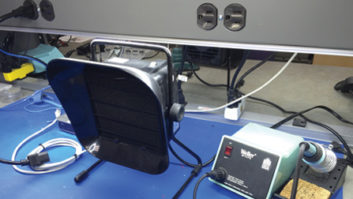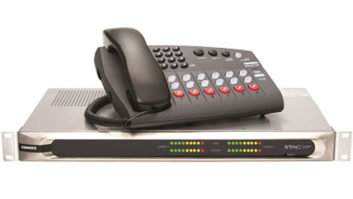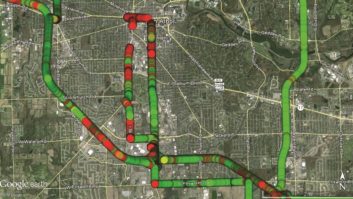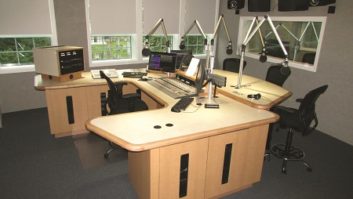Trends in Technology: Digital Audio Workstations
Sep 1, 2002 12:00 PM, By Mitch Todd
When I began my broadcasting career as a disc jockey, I quickly realized doing production was really the part that interested me. I could hide in my little room and manipulate the audio, refine it, polish it and have as many takes as I wanted, unlike live radio.
The Orban Audicy is the legacy of the first DAW with a hardware control interface designed for radio production.

I have worked with several workstations since I gave up my one-inch eight-track sometime in the 90s. I, as many of my contemporaries did at the time, lusted for the Holy Grail of radio workstations, the AKG (and later, Orban) DSE 7000. It certainly freed up the creative process and was a big step up in functionality from my old trusty one-inch machine.
While I loved the functional aspects of my new hiss-free DSE, I didn’t like the sound of it. The station engineers kept everything locked at a 32kHz sampling rate due to limited disc space. The result was plastic-sounding audio. In time the station installed larger drives, moved up to 44.1kHz and eventually accepted digital as the way to go. One of the features that made it so successful to broadcasters was its ability to emulate many aspects of an analog multitrack. The machine was designed to act like an analog eight-track with some new capabilities. The biggest advantage was the short learning curve and ease of use for people who hate manuals and aren’t PC specialists. This is why the DSE was so popular in the radio environment, despite its initial price of around $40,000. This user interface established a new way looking at DAWs.
A DAW control surface creates a familiar work space for users and can be quicker than navigation with a mouse.

There are a lot of computer-based and stand-alone workstations on the market today. The current Orban workstation, called Audicy, is still a viable workstation operating on the original DSE principles but with more tracks and features. It is useful for broadcast applications without complex needs.
However, when I began using Protools I realized how many features I had been missing using the Audicy. The most important features were additional tracks and being able to automate mixing.
About the time I wanted to add computer editing at my home studio and was dreading the cost, along came Sytrillium’s Cool Edit Pro. Cool Edit was intuitive, precise and inexpensive. I realized it had some limitations for professional use, mainly the quality of the built-in effects, but it was a lot of bang for the buck. It also worked on a wide range of PCs with various hardware configurations. I thought the editor offered some great features and good visual resolution of the waveforms, and the multitrack screen was functional and easy to use.
Things began to shift among the more advanced producers who wanted more flexible, functional, software that could quickly create more complex production. As budgets began to shift in the industry expensive, stand-alone, proprietary hardware/software workstations began looking less attractive. Cool Edit has become a popular, flexible, cost effective editor in many professional broadcast applications, and if a budget is your main concern it’s a decent choice for production rooms. Meanwhile, other software manufacturers were responding to the pro and semi-pro users of studio recording equipment.
Continued evolution
While Syntrillium products evolved from the consumer world, many companies that looked to the professional and prosumer market were making some good, cost effective products. Sonic Foundry is one notable mention. Vegas Video (formerly just an audio multitrack application called Vegas) is a powerful audio and video multitrack application with some decent effects. The audio-editing application Sound Forge and loop mixing software Acid Pro are a powerful set of tools that coexist well for less than $1,000 if you shop around.
Because the skill level of a radio station DAW user can vary, basic operation should be easy for anyone to grasp. More powerful functions can used by more experienced users.

I know by now some Macintosh users are feeling left out, but with the exception of Protools, most broadcasters prefer PCs. Protools was originally a Mac-based hardware and software package and grew from a multitrack system to a powerful swiss army knife for any audio application: recording and mixing music, mixing and sweetening audio for film and television, and other pro-audio post production. Protools has made strong inroads in larger market radio-production rooms. As plug-ins have advanced, saving rack space and dollars and adding a lot of features, it is now a universally accepted application for a wide range of professional uses. It has come to be that most high-end audio professionals and production directors know at least the basics of Protools. If a producer is going to actually use and learn all the tools at his disposal, then a Protools rig loaded with plug-ins is a great way to go. Adding the controller control surface makes it a versatile, ergonomic package.
The evolution has continued with several control surfaces now available from Digidesign. Some third-party hardware manufacturers also build control units that interface with Protools and other DAWs. If the unit works well with the software, then a control surface is a worthwhile investment. Orban realized the importance of a good control surface and that radio producers would make the transition from analog to digital much easier if their new machine emulated what they already knew. Reliance on hardware-based user interfaces will fade over time as more of the younger generation, who were born with a mouse in their hand, move into our industry and mouse and trackball technology evolves ergonomically.
So many choices
When deciding which workstation configuration to use in your facility, first define several parameters and needs. Decide what can be spent. This will reduce the available choices. Key features to consider are networking, session compatibility with outside studios, flexibility for future expansion and MIDI capabilities. Keep in mind the ability of the users that will use the system.
As computer hardware, operating systems and new methods of storage and connectivity evolve for PCs and Macs, the combinations of hardware, software and user interfaces for DAW use are evolving equally fast. On top of that, many new proprietary, self-contained units are on the market. This makes the choices in the current state-of-the-art workstations much larger and more flexible than just a couple years ago. It also makes it easier to create higher quality work than ever before with an inexpensive set up. But there is also something to be said for a system design that has been around a while and proven in the field and proven over time.
By now you probably realize that it’s not easy to make an apples-to-apples comparison of various workstations because of all the different features and considerations.
There are many products being used in radio applications such as Cakewalk’s Home Studio and Sonar software, Emagic’s Logic Platinum software/hardware combo, Mark of the Unicorn’s Digital Performer software, Sadie software and workstations, SAW studio software, Steinberg’s Cuebase series of software and others. There are also stand-alone hard disk recording systems/workstations from Fostex, Mackie, Roland, Tascam, Yamaha and others that have a lot of powerful functions. Two reasonably priced, self-contained solutions are the Yamaha Pro Audio AW4416CDHD and the Roland VS-2480CD. Both have balanced ins and outs, 24-bit resolution and built-in CD-RWs. Another workstation that has found acceptance in the world of radio is the Sadie Radia that comes as software with a PCI card or a turnkey system. A step up from that in the Sadie line would be the 24-96 offered only as a turnkey modular system, scalable from eight to 32 channels of I/O.
There are myriad choices in DAWs: Mac, PC based and stand-alone units. They all have their good and bad qualities. In the past, radio has favored tried-and-true equipment that is specifically designed for broadcast. While broadcast engineers enjoy staying in familiar territory, cost considerations and other factors may induce breaking some old habits. An established budget and end-user input will tailor the decision process.
Todd is production manager for Sirius Satellite Radio, New York.





